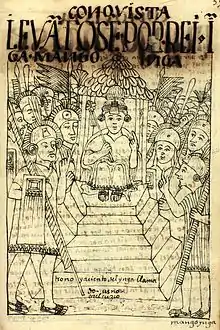| Manco II | |||||
|---|---|---|---|---|---|
 Manco Inca Yupanqui (drawing by Guaman Poma) | |||||
| Sapa Inca of the Neo-Inca State | |||||
| Reign | 1537–1544 | ||||
| Predecessor | State established | ||||
| Successor | Sayri Tupaq | ||||
| Sapa Inca of the Inca Empire | |||||
| Reign | 1533–1537 | ||||
| Installation | 1533 | ||||
| Predecessor | Túpac Huallpa (as puppet Sapa Inca of the Inca Empire) Atahualpa (as legitimate Sapa Inca of the Inca Empire) | ||||
| Successor | Paullu Inca (as puppet Sapa Inca of the Inca Empire) | ||||
| Born | c. 1515 Cusco, Inca Empire, modern-day Peru | ||||
| Died | 1544 (aged 29) Vilcabamba, Neo-Inca State, modern-day Peru | ||||
| Consort | Cura Ocllo | ||||
| Issue | Sayri Túpac, Titu Cusi, Túpac Amaru, Cusi Huarcay | ||||
| |||||
| Quechua | Manqu Inka Yupanki | ||||
| Spanish | Manco Inca Yupanqui | ||||
| Dynasty | Hanan Qusqu | ||||
| Father | Huayna Capac | ||||
Manco Inca Yupanqui (around 1515 – 1544) (Manqu Inka Yupanki in Quechua) was the founder and monarch (Sapa Inca) of the independent Neo-Inca State in Vilcabamba, although he was originally a puppet Inca Emperor installed by the Spaniards. He was also known as "Manco II" and "Manco Cápac II" ("Manqu Qhapaq II"). He was one of the sons of Huayna Capac and a younger brother of Huascar.[1]: 150
Biography
Origin and enthronement
Manco Inca, one of the more than 50 sons of Huayna Capac, was born in Cusco.[2] When Atahualpa's troops took the city under the command of General Quizquiz, they killed the descendants of Huayna Capac, the Huascar supporters, and anyone who could try to take the place of the Inca. Because of this, Manco Inca was forced to flee, avoiding any contact with the atahualpists.[3]
On 14 November, 1533, he met the conquistador Francisco Pizarro and his contingent, both Inca and Spanish. This and other events such as the massacre of Atahualpa led Manco Inca to believe that the Spaniards were "saviors" sent by the gods.[3]
Túpac Huallpa was a puppet ruler crowned by Francisco Pizarro.[1]: 210 After his death, Manco Inca joined Francisco Pizarro and Diego de Almagro in Cajamarca. When Pizarro's forces arrived in Cusco, he had the caciques acknowledge Manco as their Inca. Manco Inca then joined Almagro and Hernando de Soto in pursuit of Quizquiz.[4]: 38, 40, 46
When Pizarro left Cuzco with Almagro and Manco Inca, for Jauja in pursuit of Quizquiz, Francisco left his younger brothers Gonzalo Pizarro and Juan Pizarro as regidores, and a ninety-man garrison in the city.[1]: 222, 223, 227
The Pizarro brothers so mistreated Manco Inca that he ultimately tried to escape in 1535. He failed, was captured and imprisoned. Hernando Pizarro released him to recover a golden statue of his father Huayna Capac. Only accompanied by two Spaniards, he easily escaped a second time. Manco then gathered an army of 200,000 Inca warriors and laid siege to Cusco in early 1536, taking advantage of Diego de Almagro's absence.[1]: 235–239
After ten months (see the siege of Cuzco), Manco retreated to the nearby fortress of Ollantaytambo in 1537. Here Manco successfully defended attacks by the Spaniards in the battle of Ollantaytambo.[1]: 247–249
Manco coordinated his siege of Cusco with one on Lima, led by one of his captains, Quiso Yupanqui. The Incans were able to defeat four relief expeditions sent by Francisco Pizarro from Lima. This resulted in the death of nearly 500 Spanish soldiers. Some Spaniards were captured and sent to Ollantaytambo.[1]: 243, 246 [5]: 102–103
Alonso de Alvarado was sent by Pizarro to Cusco, but upon his arrival at Abancay, he and his army were captured by Rodrigo Orgóñez in the Battle of Abancay. This was the beginning of the first civil war between the conquistadors.
Abandoning Ollantaytambo (and effectively giving up the highlands of the empire), Manco Inca retreated to Vitcos and finally to the remote jungles of Vilcabamba,[6]: 131 where he founded the Neo-Inca State which lasted until the death of Túpac Amaru in 1572. From there, he continued his attacks against the Wankas (one of the most important allies of the Spaniards), having some success after fierce battles, and to the highlands of present-day Bolivia, where after many battles his army was defeated.
The Spaniards crowned his younger half brother Paullu Inca as puppet Sapa Inca after his retreat for his valuable help in that last campaign.[5]: 9 The Spanish succeeded in capturing Manco's sister-wife, Cura Ocllo, and had her brutally murdered in 1539.
Death
After many guerrilla battles in the mountainous regions of Vilcabamba, Manco was murdered in 1544 in the Inca center of Vitcos by supporters of Diego de Almagro who had previously assassinated Francisco Pizarro and who were in hiding under Manco's protection. They in turn were all killed by Manco's soldiers.[1]: 326
Manco was succeeded by his son Sayri Tupaq.[5]: 10 Manco Inca had several sons, including Sayri Tupaq, Titu Cusi, and Túpac Amaru.
.jpg.webp)
.jpg.webp)
See also
References
- 1 2 3 4 5 6 7 Prescott, W.H., 2011, The History of the Conquest of Peru, Digireads.com Publishing, ISBN 9781420941142
- ↑ biografica.info (ed.). "Biografía de Manco Cápac II o Manco Inca" (in Spanish). Archived from the original on 11 August 2017. Retrieved 21 March 2008.
- 1 2 Angles Vargas, Víctor (1988). Historia del Cusco incaico (in Spanish) (3 ed.). Lima, Peru: Industrial gráfica S.A. pp. 124–125.
- ↑ Pizzaro, P., 1571, Relation of the Discovery and Conquest of the Kingdoms of Peru, Vol. 1–2, New York: Cortes Society, RareBooksClub.com, ISBN 9781235937859
- 1 2 3 Titu Cusi Yupanqui, 2005, An Inca Account of the Conquest of Peru, Boulder: University Press of Colorado, ISBN 9780870818219
- ↑ Garcilaso De La Vega El Inca, 2006, Royal Commentaries of the Incas and General History of Peru, Indianapolis: Hackett Publishing Company, Inc., ISBN 9780872208438